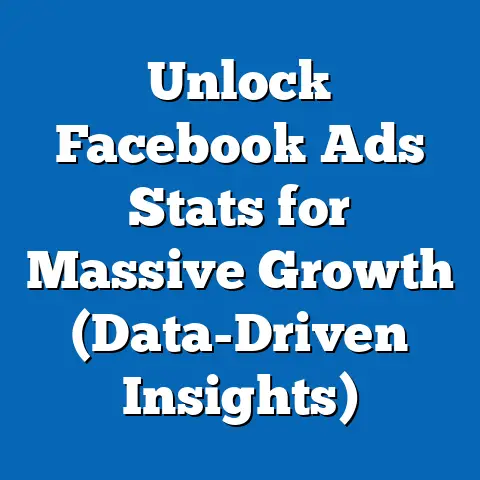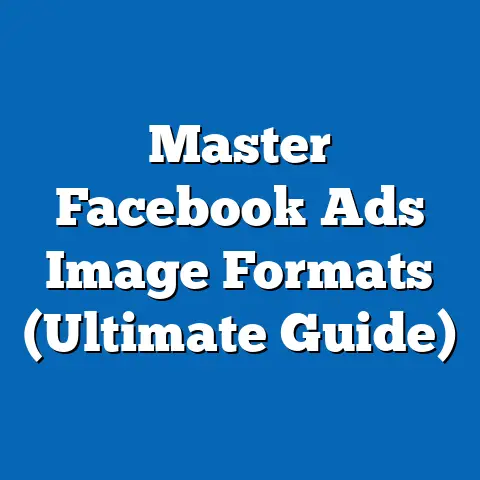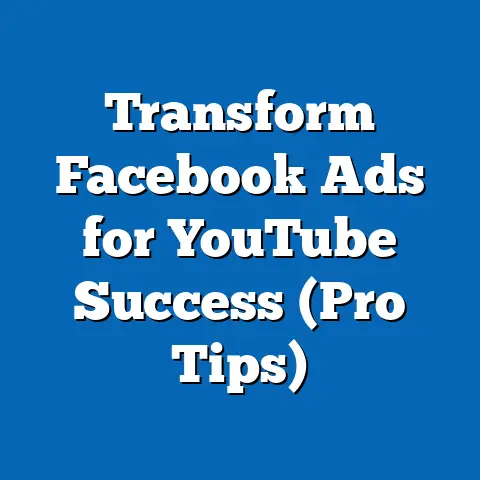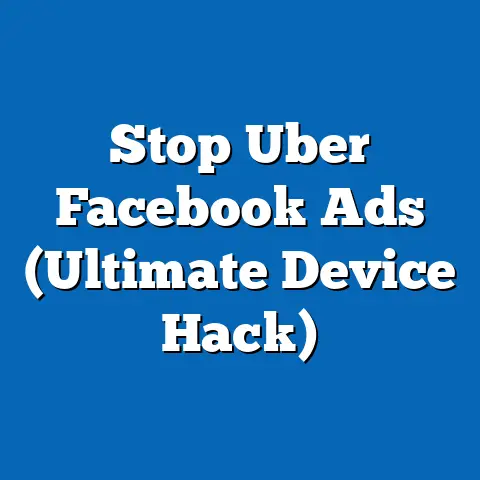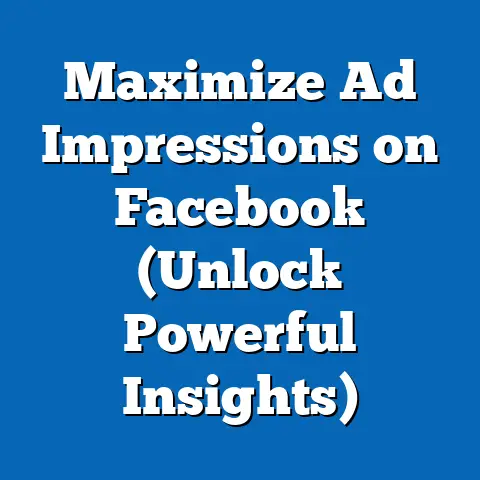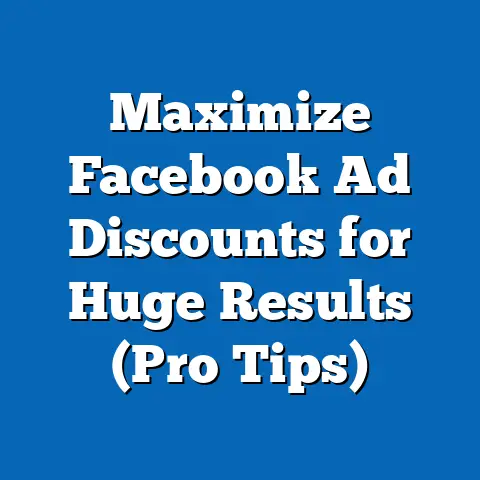Reduce Facebook Ad Costs (Proven Strategies Inside)
Are you tired of watching your Facebook ad budget disappear faster than free samples at a trade show? I get it. The feeling of pouring money into Facebook ads, only to see minimal returns, is frustrating. It’s like shouting into a crowded room and hoping someone, anyone, will hear you. But what if I told you there are “quick fixes” – not magic wands, but strategic tweaks – that can significantly reduce your Facebook ad expenses and boost your ROI?
Think of it this way: Facebook advertising is a powerful engine, but without proper tuning, it can guzzle fuel (your budget) without getting you very far. Whether you’re a small business owner just starting out or a seasoned marketing pro, understanding how to optimize your ad spend is crucial. We all want to reach our target audience effectively, but we want to do it without breaking the bank.
In this guide, I’ll be sharing proven strategies that I’ve learned over years of managing Facebook ad campaigns – some from hard-won experience, others from analyzing successful (and unsuccessful!) campaigns. We’ll dive into everything from laser-focused targeting to crafting compelling ad creatives, mastering bidding strategies, and embracing the power of continuous testing. Get ready to turn your Facebook ad campaigns into lean, mean, ROI-generating machines.
Understanding Facebook Ad Costs
Before we start slashing expenses, it’s essential to understand how Facebook ad costs are calculated. It’s like understanding the rules of the game before you play. Facebook uses an auction-based system where advertisers bid for ad placements. The cost you pay is influenced by several factors, but let’s break down the common pricing models:
- Cost Per Click (CPC): This is the amount you pay each time someone clicks on your ad. It’s great for driving traffic to your website or landing page.
- Cost Per Mille (CPM): “Mille” means thousand. CPM is the cost you pay for every 1,000 impressions (times your ad is shown). This is often used for brand awareness campaigns.
- Cost Per Acquisition (CPA): This is the cost you pay for each conversion, such as a purchase, lead, or download. It’s ideal for campaigns focused on specific actions.
So, what influences these costs? A few key factors:
- Competition: The more advertisers targeting the same audience, the higher the prices. Think of it as rush hour on a highway – more cars, slower (and more expensive) the ride.
- Audience Size: Smaller, more niche audiences can be more expensive to reach than broader audiences.
- Ad Relevance: Facebook rewards ads that are relevant to the audience. A higher relevance score can lower your costs and improve your ad delivery.
- Placement: Where your ad appears (Facebook News Feed, Instagram Stories, etc.) can affect the cost.
The key takeaway here is that understanding these factors is the first step toward controlling your ad costs. You need to know what you’re measuring and why it matters. That’s why I always tell my clients to get comfortable with Facebook Ads Manager and its reporting features. Knowing your metrics is like having a GPS for your campaign – it helps you stay on course and avoid costly detours.
Next Steps: Familiarize yourself with Facebook Ads Manager and its reporting features. Track your CPC, CPM, and CPA to establish a baseline for your campaigns.
Optimize Your Targeting
This is where the magic really happens. I’ve seen campaigns transformed overnight just by refining the targeting. Think of it as using a sniper rifle instead of a shotgun – you’re aiming for precision, not just spraying and praying.
Facebook offers a treasure trove of targeting options:
- Demographic Targeting: This includes basic information like age, gender, location, education, and job title.
- Interest Targeting: This allows you to target people based on their interests, hobbies, and pages they like.
- Behavioral Targeting: This targets people based on their online behavior, purchase history, and device usage.
- Custom Audiences: This is where you can upload your own customer data (email lists, phone numbers) to target your existing customers or create lookalike audiences.
- Lookalike Audiences: This allows you to find new people who are similar to your existing customers. It’s like cloning your best customers!
Here are some strategies to refine your targeting and reduce costs:
- Use Custom Audiences: Upload your email list and target your existing customers. They’re already familiar with your brand, so they’re more likely to convert.
- Create Lookalike Audiences: Use your Custom Audiences to create Lookalike Audiences and expand your reach to new potential customers.
- Layer Targeting Options: Combine different targeting options to create a more specific audience. For example, target women aged 25-35 who are interested in yoga and live in California.
- Exclude Audiences: Exclude people who have already purchased your product or service to avoid wasting money on retargeting them.
- Regularly Update Audience Data: Keep your audience data fresh by updating your email lists and customer data regularly.
I once worked with a local bakery that was struggling with their Facebook ad costs. They were targeting everyone in their city, which was a huge waste of money. We refined their targeting to focus on people who were interested in baking, desserts, and local food. We also created a Custom Audience of their email subscribers and a Lookalike Audience based on that. The result? Their ad costs were cut in half, and their sales skyrocketed.
Next Steps: Review your current targeting options. Are you targeting too broadly? Can you refine your audience using Custom Audiences, Lookalike Audiences, or layered targeting?
Enhance Ad Relevance and Quality
Facebook prioritizes ads that are relevant and engaging to its users. This means that if your ads are boring, irrelevant, or low-quality, they’re going to cost you more. It’s like trying to sell ice to Eskimos – if it’s not relevant, it’s not going to work.
So, what makes an ad relevant and high-quality?
- Compelling Visuals: Use high-quality images or videos that grab attention and tell a story.
- Clear Messaging: Communicate your message clearly and concisely. Avoid jargon and focus on the benefits of your product or service.
- Strong Calls-to-Action: Tell people what you want them to do. Use clear and concise calls-to-action like “Shop Now,” “Learn More,” or “Sign Up.”
- Relevance to Audience: Make sure your ad is relevant to the audience you’re targeting. Use language and imagery that resonates with them.
- Landing Page Experience: Ensure your landing page is relevant to your ad and provides a seamless user experience.
Facebook also uses an Ad Relevance Score to measure the quality and relevance of your ads. This score is based on several factors, including:
- Positive Feedback: The number of likes, shares, and comments your ad receives.
- Negative Feedback: The number of people who hide your ad or report it as spam.
- Post-Click Experience: The quality of your landing page and the likelihood that people will take the desired action.
A higher Ad Relevance Score can lower your costs and improve your ad delivery. Here are some strategies to improve your Ad Relevance Score:
- Create High-Quality Ad Content: Use compelling visuals, clear messaging, and strong calls-to-action.
- Target the Right Audience: Make sure your ad is relevant to the audience you’re targeting.
- Improve Your Landing Page Experience: Ensure your landing page is relevant to your ad and provides a seamless user experience.
- Monitor Your Ad Relevance Score: Keep an eye on your Ad Relevance Score and make adjustments as needed.
I remember working with an e-commerce store that was selling handmade jewelry. Their ads were generic and didn’t really showcase the unique beauty of their products. We revamped their ad creatives with high-quality images and videos that highlighted the craftsmanship and artistry of their jewelry. We also refined their messaging to focus on the emotional connection people have with jewelry. The result? Their Ad Relevance Score increased, their ad costs decreased, and their sales went through the roof.
Next Steps: Review your ad creatives. Are they high-quality and relevant to your audience? Can you improve your messaging or calls-to-action? Monitor your Ad Relevance Score and make adjustments as needed.
Budgeting and Bidding Strategies
Setting a realistic budget and choosing the right bidding strategy are crucial for minimizing costs. It’s like managing your personal finances – you need to know how much you can afford to spend and how to allocate your resources wisely.
Facebook offers two main budgeting options:
- Daily Budget: This is the average amount you’re willing to spend each day.
- Lifetime Budget: This is the total amount you’re willing to spend over the entire duration of your campaign.
The best option depends on your goals and how much control you want over your ad spend. If you’re just starting out, I recommend using a daily budget. This allows you to test different ad creatives and targeting options without blowing your entire budget.
When it comes to bidding strategies, Facebook offers two main options:
- Automatic Bidding: Facebook automatically sets your bids to get the most results for your budget. This is a good option for beginners.
- Manual Bidding: You set your bids manually, giving you more control over your ad spend. This is a good option for experienced advertisers who want to optimize their bids for specific goals.
If you’re using manual bidding, you need to understand how to set your bids to minimize costs. Here are some tips:
- Start Low: Start with a low bid and gradually increase it until you start seeing results.
- Monitor Your Performance: Keep an eye on your performance and adjust your bids as needed.
- Use Bid Caps: Set bid caps to prevent Facebook from overspending on your ads.
- Consider Your Goals: Adjust your bids based on your goals. If you’re focused on conversions, you may be willing to pay more per click.
I once worked with a startup that was launching a new mobile app. They had a limited budget and needed to maximize their reach. We used a daily budget and automatic bidding to start. As we gathered data, we switched to manual bidding and optimized our bids based on our goals. We also used bid caps to prevent Facebook from overspending on our ads. The result? We were able to acquire a large number of users at a very low cost.
Next Steps: Review your budgeting and bidding strategies. Are you setting a realistic budget based on your goals? Are you using the right bidding strategy for your experience level?
Continuous Testing and Optimization
Facebook advertising is not a “set it and forget it” kind of thing. It’s a continuous process of testing, learning, and optimizing. It’s like gardening – you need to constantly tend to your plants to help them grow.
A/B testing is a powerful tool for optimizing your Facebook ad campaigns. It allows you to test different versions of your ads to see which one performs best. You can test different:
- Images: Try different images to see which one grabs the most attention.
- Headlines: Test different headlines to see which one generates the most clicks.
- Body Copy: Experiment with different body copy to see which one resonates with your audience.
- Calls-to-Action: Try different calls-to-action to see which one drives the most conversions.
- Audience Segments: Test different audience segments to see which one is most responsive to your ads.
Here’s how to set up an effective testing framework:
- Identify Your Goals: What do you want to achieve with your testing? Do you want to increase clicks, conversions, or engagement?
- Choose Your Variables: What elements of your ad do you want to test?
- Create Your Variations: Create different versions of your ad with different variables.
- Run Your Tests: Run your tests for a sufficient amount of time to gather enough data.
- Analyze Your Results: Analyze your results and identify the winning variations.
- Implement Your Changes: Implement the winning variations in your campaigns.
- Repeat the Process: Continue testing and optimizing your campaigns over time.
I worked with a clothing retailer that was struggling to increase their online sales. We set up an A/B testing framework to test different ad creatives, headlines, and calls-to-action. We tested different images of their clothing, different headlines that highlighted the benefits of their products, and different calls-to-action that encouraged people to shop now. We ran our tests for two weeks and analyzed the results. We found that the winning variations generated significantly more clicks and conversions. We implemented the winning variations in their campaigns, and their online sales increased by 30%.
Next Steps: Set up an A/B testing framework for your Facebook ad campaigns. Test different ad creatives, headlines, and calls-to-action to see which ones perform best.
Conclusion
Reducing Facebook ad costs is not about finding a magic bullet. It’s about understanding the platform, implementing proven strategies, and continuously testing and optimizing your campaigns. By focusing on precise targeting, high-quality ad creatives, strategic budgeting and bidding, and continuous testing, you can significantly reduce your ad expenses and boost your ROI.
I encourage you to take action based on the strategies I’ve shared in this guide. Start by reviewing your current campaigns and identifying areas for improvement. Implement the strategies that are most relevant to your business and track your results. Remember, Facebook advertising is a marathon, not a sprint. It takes time and effort to optimize your campaigns and achieve your goals. But with the right approach, you can thrive by effectively managing your advertising expenses on Facebook.
Call to Action:
I’d love to hear about your experiences with Facebook ads! Share your successes, your challenges, and any additional strategies that have worked for you in the comments section below. And don’t forget to follow my page for more insights and updates on digital marketing trends and strategies. Let’s continue the conversation and help each other succeed in the ever-evolving world of digital advertising!

